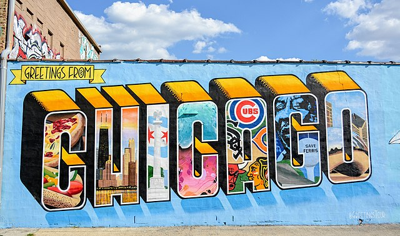Chicago’s street art scene is a vibrant reflection of the city’s diverse cultures, histories, and social issues. What began as graffiti has evolved into large-scale murals celebrated as a public form of expression. While it may seem spontaneous, street art in Chicago has evolved into a carefully coordinated and celebrated form of public expression, influenced by local culture, community engagement, and city policies.
Starting in the late 1970s and early 1980s, graffiti in Chicago was driven by youth on the South and West sides. Inspired by hip-hop culture, these artists used spray paint to leave elaborate tags and stylized lettering. What began as a form of rebellion and expression of identity eventually evolved into a more organized and recognized art form.
Early graffiti writers, such as Michael "Marz" Marzullo, helped lay the groundwork for a more organized street art culture. In the 1990s, groups like the Chicago Public Art Group (CPAG) shifted the focus toward murals as a form of community expression, often reflecting social and political issues.
The Pilsen neighborhood became a hub for murals that celebrated Mexican American culture, with figures like Carlos Cortez leading the way. The Rebuild Foundation, founded by artist Theaster Gates, helped bridge art with urban renewal, revitalizing neighborhoods and giving rise to large-scale installations. These figures and movements contributed to transforming street art from an underground subculture to a recognized form of public art that now thrives in Chicago’s urban landscape.
In the heart of Hyde Park, a new public art project is enhancing the neighborhood's cultural landscape. The Viaduct Art Gallery transformed the 53rd and 55th Street viaducts into vibrant displays, featuring nineteen large-scale vinyl reproductions of local artwork. Launched in May 2025, this initiative, a collaboration between Special Service Area #61, CPAG, and the Southeast Chicago Commission, showcases pieces selected from over 600 submissions. The art spans thirteen panels on 53rd Street and six on 55th Street, turning the viaducts into a public art corridor.
The Chicago Department of Cultural Affairs and Special Events (DCASE) oversees all of the city’s public art programs, which include murals and installations created as part of public initiatives. Artists or organizations wishing to create large-scale murals in public spaces may need to apply for permits or undergo a review process to ensure that the artwork aligns with city guidelines and regulations.
One notable program that influences the placement of street art in Chicago is the Percent-for-Art program, which mandates that specific public building projects allocate a portion of their budget for public art. In some instances, this includes murals or street art installations that become part of a broader public development project.
Despite the frameworks in place, street art in Chicago is not solely governed by city regulations or community initiatives. Many street artists continue to create works independently, often in less conventional spaces.
Today’s street artists are more likely to be involved in collaborative projects and organized festivals. Events such as the Pilsen Murals Festival and the Wabash Arts Corridor bring together artists, property owners, and the public to create large-scale installations and murals that reflect both the city’s vibrancy and its collective identity.
Chicago also offers a wide range of street art tours, catering to both enthusiasts and those casually interested in exploring the city’s dynamic urban landscape. Whether guided or self-guided, these tours offer a deep dive into the city's street art history, showcasing notable pieces and the artists behind them. For more information on these tours, follow the links below.








(0) comments
Welcome to the discussion.
Log In
Keep it Clean. Please avoid obscene, vulgar, lewd, racist or sexually-oriented language.
PLEASE TURN OFF YOUR CAPS LOCK.
Don't Threaten. Threats of harming another person will not be tolerated.
Be Truthful. Don't knowingly lie about anyone or anything.
Be Nice. No racism, sexism or any sort of -ism that is degrading to another person.
Be Proactive. Use the 'Report' link on each comment to let us know of abusive posts.
Share with Us. We'd love to hear eyewitness accounts, the history behind an article.